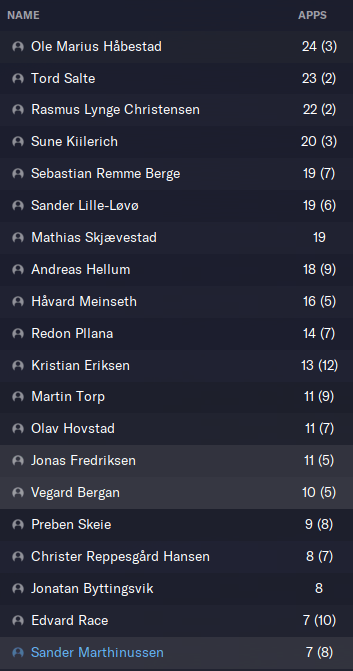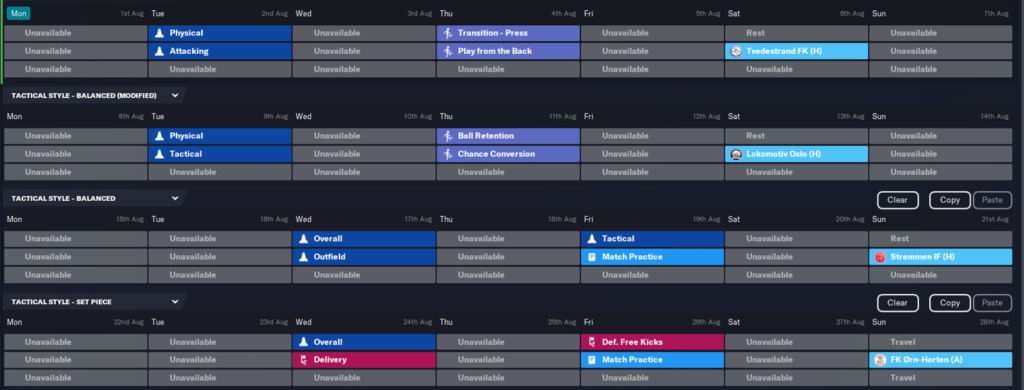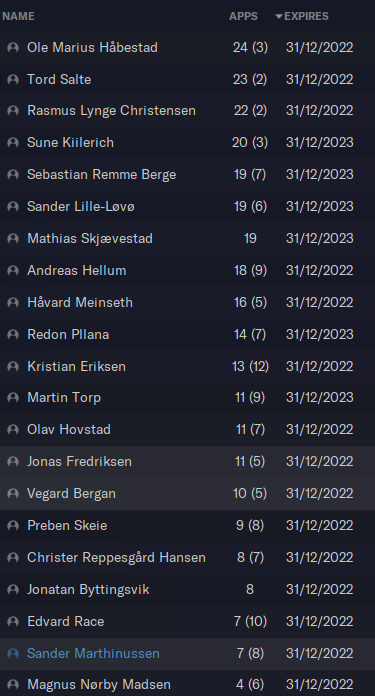
Going (Semi-Pro): Life as a Lower League Manager
In FM23, I’ve gone Semi-Pro. For the first time in my Content Creation days, my chosen club is a semi-professional side – Arendal Fotball in Norway’s Third Tier. Life here as a Lower League Manager is simple. We are a modestly financed club, our is a blend of professional and amateur players and we train twice a week to play a game at the weekend. While the ability to turn professional could become an opportunity that we take in the future, at the moment our situation is totally different to the experiences I have had in recent years and FM-editions. As such, I now play the game in a totally different way. I have had to change in order to embrace lower league management, and I would like to share with you how I have done so. I have compromised between the principles that define elite managers and the circumstances of only seeing my players on Tuesdays & Thursdays.
Here’s how I’ve done it.
Team Selection

I wanted this to be somewhat of a Youth Development save, given the modest financial situation at the club. However, we have just the 6 players between our Reserves & U18s and no Head of Youth Development, so that was shelved almost immediately. On Day 1 of the save, I was informed that my first choice keeper would be unavailable for several months and the only keeper at the club was 16 years old. I signed two “greyed” out ‘keepers so each team at the club could have at least one “real” option.
Consistency became the key. Minimal training time and a good sized squad allowed for easy rotation game-on-game. I tried to keep it to a maximum of three changes to ensure a level of continuity from game-to-game. In doing so, I also tried to ensure that players missed a maximum of two games to maintain a good level of sharpness. Changes like this did affect us tactically, as some players play the position differently but each player brought different strengths to the side that we tried to blend as best as we could. What also helped in this situation was being able to select 9 subs and make 5 during each game. This added bonus made rotation easier and kept the squad sharper. A win-win for everyone.
A positive caveat from learning to manage a squad of player in the lower leagues has been breaking a bad habit of mine – hoarding players. Unable to have a squad bursting at the seams, we were settled at around 23 players, which is a habit I never wish to break again!
Tactics
I started FM22 not wanting to play using a 4-3-3, instead break the habits of old and play with a back 3 for the first time. Old habits die hard, so I ended up playing 4-3-3 eventually. I’ve made the same promise this year, so all three tactical shapes are variations of a back 3. Keeping some level of consistency between shapes and then in Team Instructions (Philosophy) has allowed us to control games in different ways, whether it has been to slow down and see the game out, or raise the intensity and chase a much needed goal.
The one key area of tactic building I was keen to implement was a structured, out-of-possession approach. We are semi-pro, our players’ fitness levels are not that of professional players so playing an intense, counter-pressing style would be ridiculous. Instead, we focused on a compact style with a counter attacking element which would be a more realistic expectation of a team at our level.

To increase tactical familiarity, I focused on the individual as the building block of the collective. Using the Tactical Presets as the basis of the initial stages of development, I kept the vanilla roles of the style, but focused on setting up every player to have a Personalised Role in the positions I would play them in. The Personalised Roles would be based on their Natural or Accomplished roles, which were further complimented in the Individual Training profile of each player to further support this tactical familiarity. Only one player was (unhappily) retrained. This was an attacking left midfielder (who was also the Club’s Director) I needed to play at left wing back. The only fit left wing back at the club was defensively inclined and needing an attacking threat from this area of the pitch, I was left with no option but to force the change. Despite his unhappiness, his 14 assists in the 24 league games was an Individual high for the division, so the data suggests it was a change that was worth persisting with.
Overall, our style was underpinned by two key elements – ball retention and direct play. I believe in playing with the ball, but at this level by maintaining possession we will exert ourselves a little less because the ball doesn’t tire like a player does. By being direct we could also work to the strengths of our forward line – two Pressing Forwards and a Target Forward, perfect for this style of play. Everything tactically was built from these points, and by ensuring our back line was the platform for moving the ball forward and an overloaded and packed central area of the pitch, we could really control the game in all phases of play.
Training
The semi-professional life of a footballer in Football Manager is not too different to the one of the lads in the park at the weekend. Train Tuesday & Thursday and play a game at the weekend. Simple life. On an average week, I am tasked to prepare 4 sessions per week (two per day) and then have a Match at the weekend.
I’ve written and spoken plenty of times before about my affinity towards a Tactical Periodisation approach to training. Patterns and rhythm help me set up base templates, so week-on-week month-on-month, I am able to develop and evolve patterns of the tactical philosophy. With a maximum of 6 sessions per week (when we have no match at the weekend), my typical training methodology needed to be trimmed down and rethought in order to embrace the challenge of lower league management.

My first port of call in building up a shape was to focus on individual roles and focuses that I set in pre-season when I settled on the tactical shapes discussed above. Any reviews to the individual approaches came in the weekly Staff Meetings. Every suggestion wasn’t necessarily acted upon, but was noted.
Once the players were catered for individually, I then took my focus to the collective. Taking what I have learned from Tactical Periodisation, I wanted to build the approach on pattern and rhythm. A weekly sessions breakdown would be:
Day 1: Physical & Possession/Ball Retention
Day 2: Att/Def Session (depending on the needs)/Set Pieces Not getting bogged down in the nitty-gritty of the Training categories, General Sessions can hold the most value when it’s quality over quantity. Taking a little time to figure out a balanced approach and ensuring over the course of a month that each area of play has a primary focus will underpin what it is you want to achieve on the pitch, howernoting where each area has a secondary and tertiary focus will also help develop all areas of play in even the smallest of ways. My poor ‘keepers never got much time dedicated to their needs primarily, but shots on the keeper was always an acceptable training session…right?!
Wanting to reach every area of play, getting in an early physical session was the key to the week. At a level where physicality means much more, these sessions were used to build and maintain the fitness levels of the squad overall. Possession & Ball Retention underpins how I want to play. It’s a key principle of my philosophy, so it was only right I spent as much time as possible training in these areas specifically. Attacking and Defending sessions were next. Sometimes a general session, others focused on specific areas, I thought of these sessions as targeting a weakness in ourselves/the opponents. Match Preparation sessions that focused on Attacking & Defensive Movements were also used here, because these sessions have a slight variation on the General Attacking & Defending sessions. Finally, there were Set-Pieces. I did no defending set-piece sessions across the full season. Instead, I alternated between attacking corners and attacking free-kicks. Set pieces are rehearsals of goal movements, so in a league where development time wasn’t really there, time spent that could almost guarantee a goal was certainly worth the dedicated weekly slot.
Transfers
I always begin every FM edition by disabling the Transfer Window. It allows for a sense of realism to exist from the beginning of the game, while also giving me a fair opportunity to appraise the squad. Operating at our current level where finances are modest, when the Summer (mid-season) Window opened, we didn’t really have the ability to make any signings. Wage wise, there was a small surplus in Budget that would allow us to bring someone in if needed, but given how we were financially haemorrhaging overall month on month, it made no sense for us to make any investment in the Playing or Technical Staffs until our bank balance looked a little healthier.

Ahead of Season Two, my emphasis will be on supplementing what we already have to make the jump from Norway’s Third to Second Tier following our promotion campaign in Season One. Primarily, our signings will be U21 players who can come in and be given time to settle in and develop themselves in their position and role on the Training ground before playing time increases as the season progresses. Eventually, they will take the place of some of the Season One squad who depart, due to age or desire, or who have reached a point where they need to take a step back from First Team football. In some areas, we will need to drop our Season One players back one slot, e.g. with a young Goalkeeper experience will be needed to come in to provide us with that bit of reassurance should our 17 year old starlet require a touch more development time on the Training Ground.
Statistics will be the main measuring stick for me to identify key targets. At present I am currently piecing together the relevant statistics to measure each position and role by, before then using my current squad as a benchmark for potental new signings. Making the jump to the OBOS-ligaen means we will look for Domestic or International players who can improve the squad. As well, players from the Post Nord-ligaen, from which we were just promoted, will be considered as some players from that Division are capable of making the jump and hopefully improve us and them by doing so.
While Statistics will provide the basis of recruitment, any potential signing will need to pass the Eye-Test. Attribute-wise, we will need to see their strengths. Traits-wise, have they got that something extra? Can they fit into the current group? These will all be questions any new potential signing will be asked before the contracts are signed.
Finally, while I hope to avoid a squad rebuild following our successes, big changes at this level are almost inevitable. Many players are out of contract, and following promotion, will look for an understandable pay rise. We may not be able to afford to renew them all. Some players have interest from the Eliteseriean, Norway’s Top Flight, and Top Flight clubs from across Europe. Who am I to compete with them?
Reflection
Way back in FM18, I played with Brommapojkarna in Sweden’s Third Tier and I loved it. The journey only lasted one season (it was a Summer fling on FM Touch), but my appetite for that level of football was satiated. In Ireland, our two League Divisions blur the lines between elite and amateur as the Top Clubs operate on a Professional basis, while those at the lower ends of the Divisions are Semi-Professional, or amateur in some cases. My playing experiences here have been enjoyable, but the league as a whole does not offer much in way of progression to a domestic, professional standard. In Norway, as in Sweden, I can take aspects of what I know from Ireland and bring it to a league where the Top Division is an elite, professional division. However, I have re-evaluated how I approach the game in all aspects since beginning in Norway with Arendal. Whittling down Tactical Periodisation to a 4 sessions per week approach but maximising effectiveness has led me to rethink my approach to training. Building a tactic from each players best roles and finding a way to blend them has me thinking about the importance of cohesion and consistency in Team Selection. I now play FM in a far simpler way than pre-FM23 and I’ve found my way now better than I could have imagined.
If you enjoyed this, then make sure to follow us on Twitter and Facebook to keep up with all Dictate The Game content. Check out my pieces for Dictate the Game! Thank you for reading!
One thought on “Going (Semi-Pro): Life as a Lower League Manager”
ottimo articolo. Grazie.